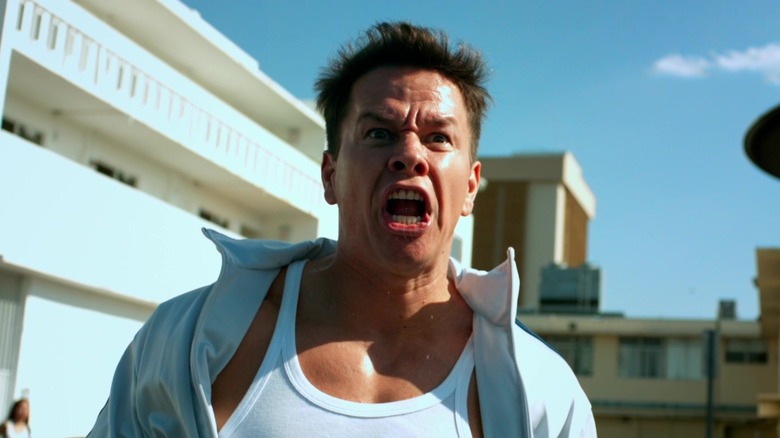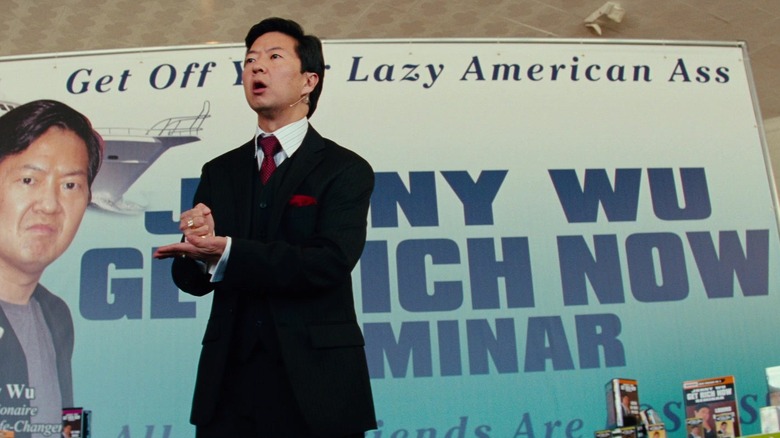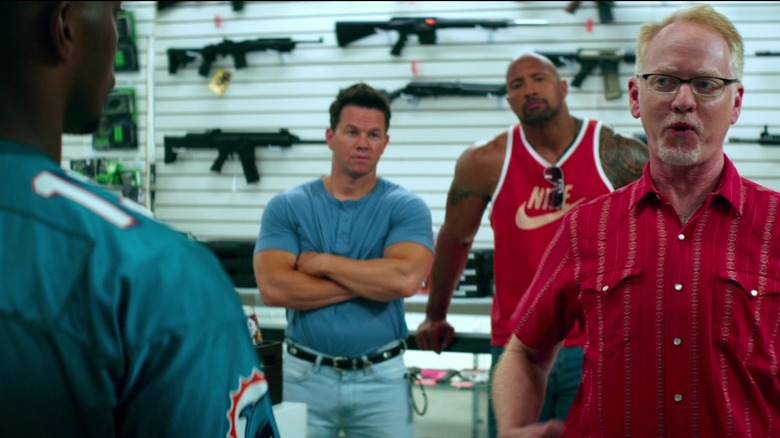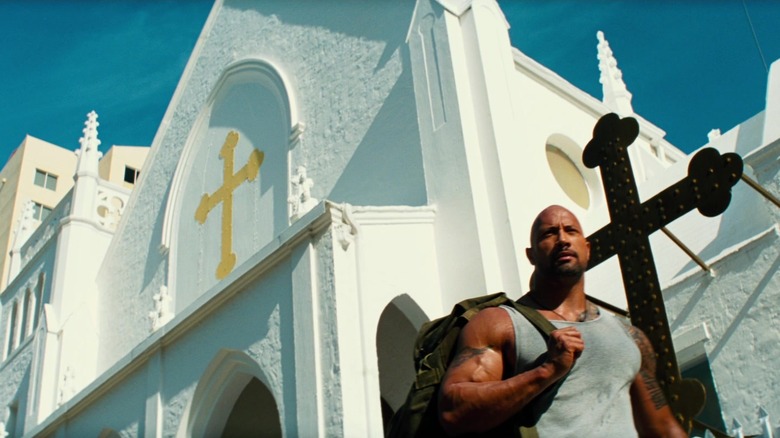The Real Life Inspiration Behind Michael Bay's Pain & Gain
I never thought I'd say this about a Michael Bay movie, but "Pain & Gain" is a modern masterpiece. While "The Rock" and "Armageddon" have found their way into Criterion's hallowed collection, this toxic crime caper is the pugnacious director's masterwork, a rambunctious distillation of everything right and wrong with the blockbuster auteur's career to date.
If you have any doubt that Bay is a true auteur, consider his movies alongside the similarly popcorn-friendly director Roland Emmerich, who has no clearly defined aesthetic of his own. You could probably identify Bay's signature style from any random screenshot from his filmography. Just as Scorsese is known for his freeze frames and Tarantino loves his in-the-trunk shots, we can all identify those characteristic Bay images. The leering objectification of women; mega-low angle hero shots; guys getting out of cars in slow-mo; fetishization of weapons and military hardware; and the stars and stripes conspicuously fluttering in the background, all shot like a ballistic, ultra-glossy beer commercial.
"Pain & Gain" is his most fascinating film, a crude and exuberant satire of... well, all Bay appears to stand for, judging by everything he's committed to screen since his "Bad Boys" debut in 1995. Like "Natural Born Killers," "American Psycho," or "Spring Breakers," it holds a mirror to the tawdry excess and least desirable aspects of Western culture. Unlike those three movies, you get the peculiar sense that Bay saw himself and his career in that mirror, decided it was awesome, and gave his reflection a big high five and a hearty "F*** yeah!"
Set in a day-glo world of musclebound Doers and pathetic Don'ters where failing to maximize your body's potential is "Un-American," "Pain & Gain" is a juiced-up Roid-noir where even the most low-key character moment is cranked with megaplex super-awesomeness. As the film states at the beginning and reiterates later during the mayhem, it was also based on a true story. But what was the inspiration, and how accurate is it?
So What Happens in Pain & Gain?
Daniel Lugo (Mark Wahlberg) gets a job at Sun Gym in Miami, despite his questionable background. He quickly improves the fortunes of the gym's owner, John Mese (Rob Corddry), by boosting membership with his cunning schemes, like giving free passes to strippers. Lugo's gym buddy is Adrian Doorbal (Anthony Mackie), a bodybuilder who can't get it up anymore thanks to his steroid use. After Lugo attends a motivational seminar (Ken Jeong at maximum intensity), he targets a rich slimeball client named Victor Kershaw (Tony Shalhoub), who he plans to kidnap and extort for all his money and material assets.
For the job, Lugo recruits Doorbal and Paul Doyle (Dwayne Johnson), a hulking ex-con who has found Jesus in his quest to quit drugs, as extra muscle. The Sun Gym Gang make several bumbling attempts to capture Kershaw before they finally succeed, holding him captive in a warehouse.
Kershaw proves a tough nut to crack but, apart from him identifying Lugo from his cologne, the plan goes reasonably smoothly. They beat and torture Kershaw until he signs over everything, including his luxury home. Once everything is done, it's time to kill him and get rid of the evidence.
That's when things don't go quite so well. Kershaw is seemingly impossible to kill, somehow surviving the gang's multiple attempts on his life. Doyle falls off the wagon after blowing through his cut, and pulls a disastrous one-man heist on an armored car. Despite the riches stolen from Kershaw, it isn't enough, and soon the gang need another wealthy target to fund their lavish lifestyles. They settle on Frank Griga (Michael Rispoli), a self-made man who made his fortune in the phone sex business. This time, the kidnapping scheme goes terribly wrong, resulting in the murder of Griga and his girlfriend.
Origins of Pain & Gain
The film was adapted from "Pain & Gain," a meaty three-parter by Pete Collins published in the Miami New Times, one of those long-reads you just dream of writing if you have ambitions of making a living in journalism. The first part dropped a few days before Christmas 1999, an unseasonably vile tale of greed, crazy masterplans, kidnapping, bodybuilding, strippers, hot cars, brazen villains, and dogged detectives. Collins later said of the article (via Miami New Times):
"I had penned this durable tale of Miami when I was backed into the corner — broke, jobless, and near bottom."
Growing up in Miami, he got a job writing for the paper in its fledgeling years, before losing it again for urinating in his editor's car. He kept up with the freelance contributions, however, with true crime stories about the city's colorful con men that brought him profile-raising appearances on shows like "60 Minutes" and "Dateline."
The genesis of "Pain and Gain" came in 1996 when Collins was trying to get his act together and bumped into a friend named Ed Du Bois while out jogging. Du Bois was the head of the longest running detective agency in the state and the NFL's top security guy in Florida, and he had a great crime story for the up-and-coming journalist.
Collins was initially reluctant, wanting to move onto something else as he was finishing his graduate writing program at Florida International University. Du Bois was persistent, and Collins found himself hooked on the many outlandish details of the case. He followed the Sun Gym Gang's exploits in court papers, and attended every day of the five month trial. The twists and turns kept coming even during sentencing of the perpetrators; after the first victim, Marc Schiller (Kershaw in the movie), returned from Colombia to testify against his tormentors, the FBI nabbed him on the courthouse steps for his involvement in Medicare fraud.
Collins spent a year writing the novella-length article, the longest piece ever published in the Miami New Times. After he earned his Masters and started teaching, Hollywood came calling.
How Accurate is Pain & Gain?
Bay's "Pain & Gain" stresses, in a jokey kind of way, that this is "unfortunately" a true story, and the basic plot points are fairly faithful to the real-life Sun Gym Gang's heinous activities. I chugged through Collins' full article and it's little surprise that such a complex case with so many bizarre wrinkles was streamlined to fit a two-and-a-bit hour movie, with many details tweaked, compressed, or omitted.
One of the biggest changes was narrowing the gang down from its ring leaders and several bit-part players to three antagonists — Lugo (Wahlberg), Doorbal (Mackie), and Doyle (Johnson), a fictional character who was a composite of three main gang members.
Wahlberg plays Lugo like Dirk Diggler's more dead-eyed, cynical, avaricious brother. While he is the gang's mastermind, that's a little like saying Ollie Hardy was the brains of the outfit. Wahlberg's Lugo has a previous criminal record, but it is played down a little, portraying him as a go-getting opportunist inspired by Jeong's loathsome self-help mentor. The real Lugo, unlike Wahlberg's apparent singleton, was married twice and also ran a lucrative Medicare scam, where he bought patient's details and billed the government for non-existent medical treatment. In the film, Kershaw identifies him by his cologne, while Schiller recognized his voice: "Mike Tyson's lisp with a New York accent."
Doorbal, played as an unassuming character by Mackie, was a far more active and violent driving force. Like his movie counterpart, he had trouble with erectile dysfunction due to steroid use, but it wasn't his future wife who sorted out a cure for him. Acquiring the expensive drug wasn't a motivator for real-life Doorbal; he was doing very well from Lugo's Medicare scam. The real Doorbal seemed to get a kick out of the violence and torture, quite willing to strangle Schiller before the gang came up with the idea of getting him steaming drunk and faking a car accident.
Doorbal was also the one who murdered Griga, not Lugo, as portrayed in the movie. Cleaning up the aftermath is portrayed as a "Bonnie Situation" race against time before Doorbal's wife gets home; real-life Doorbal's wife, Cindy, actually helped clean up the bloody mess. Later, after they were married, she realized it was a ruse to stop her testifying against her hubby. She divorced him during the trial so she could spill the beans and plead guilty to criminal mischief, only a misdemeanor.
Other Characters in Pain & Gain
Doyle, played by Dwayne "The Rock" Johnson, is a composite character of three Sun Gym Gang members — Carl Weekes, his cousin Stevenson Pierre, and Jorge Delgado, with a dash of another peripheral character thrown in for good measure. Weekes, much like Johnson's character, was an ex-con who had left New York for Miami to get his life back on track. As Collins wryly notes (via Miami New Times):
"Miami was perhaps an odd destination for someone trying to steer clear of drugs and crime, like going to Las Vegas to kick a gambling habit."
Weekes was very different from The Rock in stature and attitude, however. He was a "140 pound lightweight," and, according to his cousin Pierre who disliked him, was spoiled and impulsive, a braggart and a brat. He was only involved in the kidnapping of the first victim, Schiller, later hitting the booze and getting arrested for carrying a concealed weapon because he feared for his life from the gang. When he was approached to play a part in the second abduction, he refused, worried that Lugo & Co planned to bump him off, too.
One of the most outrageous comic set pieces in the film is when Doyle, dressed rather conspicuously in a baby blue suit jacket, robs an armored car and gets a toe shot off and a face-full of anti-theft dye for his efforts. This never happened.
Delgado, like Doyle, was the key witness who testified against Lugo and Doorbal, receiving a lighter 15-year sentence. Meanwhile, Doyle's beefcake stature was probably inspired by another bit-player in the whole messy affair, "Big" Mario Sanchez, a weightlifting instructor and down-on-his-luck private eye who clocked in at 6' 4" and 270 pounds, hired by the gang as an "Intimidator" in Schiller's kidnapping. He later turned down a $5000 offer to perform a similar role in the botched Griga abduction.
The First Victim
It was Mark Schiller's friendship with Delgado that tragically led to his kidnapping and terrible ordeal at the hands of the Sun Gym Gang. Lugo's plan centred on retrieving $200,000 that "scumbag" Schiller supposedly owed Delgado, which involved beating it out of him and killing him afterwards. In 1991, Delgado was in a perilous financial state before Schiller sympathetically took him under his wing. Soon they were friends and business partners, with Schiller putting up investment money for Delgado's business ventures. Delgado also knew the older man's finances, including his offshore holdings in the Cayman Islands.
Kershaw's indestructibility is played for laughs in the movie, but the violence Schiller suffered left him physically and emotionally shattered. He was repeatedly beaten, tasered, burnt, pistol-whipped, blind-folded, and brutally held captive for a month. The gang also threatened to rape his wife. After the gang's attempts to stage a car crash, burn him alive, and run him over failed, the hospital didn't believe his story, treating him as a John Doe brought in as DUI. He communicated with Du Bois (played by Ed Harris in the movie), who advised him to get out of hospital before the gang came to finish him off. His sister paid $6000 for a one-way air ambulance trip to New York, where he holed up and convalesced in her Long Island home. Meanwhile, his brother Alex, contacted the gang and threatened retribution.
Du Bois, who was still an active private detective unlike Harris's unhappily retired sleuth, conducted protracted negotiations with the gang to recover some of Schiller's stolen money. A deal including a dubious "agreement to silence" was proposed, featuring another Lugo stroke of genius — making the contract out for 1.26 million lire instead of 1.26 million dollars, in the hope that Schiller and his legal team wouldn't notice. Eventually, it became apparent that the deal was just a way of stalling for time. Meanwhile the gang, who had settled into his plush house, completely cleared it out, even taking the light switches. When Schiller finally got his home back, it was bare.
The Girlfriends
As the real-life gang made several failed attempts to grab Schiller, ringleader Lugo would take them to Miami's top strip joint, the Solid Gold Club, to whet their appetites with what they could win if they successfully pulled off the caper, namely "voluptuous naked centrefold fantasies." Lugo set his sights on high-end stripper Sabina Petrescu (Sorina Luminita, played by Bar Paly in the movie), who really had made her way into the US in the trunk of a car from Mexico, traveling from Bucharest via Moscow and Cuba.
She found work, mostly involving taking her clothes off, and modeled for Penthouse before landing in Miami where she met with Lugo and the gang. Unlike the movie, she wasn't passed on to the Doyle character, or any of Lugo's cohorts. Not known for her cerebral skills, she was convinced by Lugo's claims that he worked for the CIA, and was tangentially involved in some of the gang's schemes. When Lugo was finally arrested by a multi-agency task force in Nassau, Bahamas, he was with Sabina and her parents.
The stripper girlfriend of Doorbal, Beatriz Weiland, inadvertently led to the demise of Griga. Doorbal saw a photo of her mum posing next to a quarter of a million dollar Lamborghini, and wanted to know who owned it. It was Griga's car, one of Weiland's former lovers. The connection was made, and Lugo and Doorbal, proposing a healthy investment scheme, worked their way into a position to grab the self-made millionaire and give him the old Schiller treatment. This time, it went disastrously, gruesomely wrong.
Does Pain & Gain Respect the True Crime?
The big question is, does Bay's shallow, pyrotechnic style suit the crime? The Sun Gym Gang case was particularly ugly and vicious, motivated by pure greed. Schiller, beaten and tortured, was permanently affected by his ordeal. Yet he got off lightly compared to Griga and his girlfriend, Krisztina Furton. Not only were they ambushed, beaten, drugged, and murdered, they suffered the further indignity of dismemberment before they were dumped in barrels full of chemicals. If I have one criticism of Collins' article, it's that he lingers on the grisly details rather than cut away out of respect to the victims and their families.
"Pain & Gain" received some backlash in this respect. Zsuzsanna Griga, sister of murder victim Frank Griga, said she didn't want the film to make the American public sympathize with the killers (via The Huffington Post). I totally understand her point, and I can't imagine what it must be like to have someone make such a crazy movie about the murder of a family member. Yet taking a blackly comedic approach doesn't make the gang members any more sympathetic; if anything, it just makes them seem dumber and more pathetic. We're left in little doubt that these are the worst kind of people; stupid, desperate, jealous, greedy, venal, feeling entitled to take what isn't theirs by force in a brutal attempt to shortcut the American Dream. Without Bay's adaptation, maybe the story would have ended up as another one of those dreary true-life crime stories that are ten-a-penny on Netflix these days. The outlandish details, noxious materialism, and bare-faced avarice at the core of "Pain & Gain" sets it apart from most other true crime tales, and ultimately it found its perfect match in the lurid excesses of Michael Bay.







